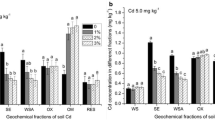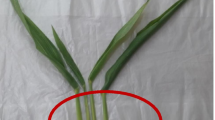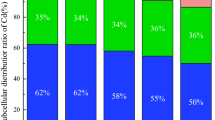Abstract
Immobilization of soil cadmium (Cd) has been the strategy mostly used in remediation of Cd-contaminated arable soil. However, Cd might be remobilized after the immobilization process through the acid-soluble and complexation effects. Development of agronomic management technologies to prevent soil Cd remobilization after the immobilization process was an important pathway to control the food safety of agricultural products in soils with the immobilized Cd. In this study, the ammonia (NH4+-N) and nitrate (NO3−-N) forms with concentrations of 60, 90, and 150 mg-N kg−1 soil were performed for evaluating their effects on Cd remobilization with planted or unplanted treatments and Cd accumulation in tissues of edible amaranth (Liuye). With an initial soil palygorskite-bound fraction Cd concentration of 0.6 mg kg−1, bioavailable Cd in rhizosphere soils and Cd in crop shoots respectively increased from 11.4 to 20.6 μg kg−1 (dry soil weight) and 6.92 to 14.92 mg kg−1 (dry plant weight) in planted NH4+-N treatments, while significantly lower concentrations of bioavailable Cd in rhizosphere soils and Cd in crop tissues were observed with planted NO3−-N treatments. Compared with that of planted NO3−-N treatments, decreasing pH value (i.e., 7.64 to 7.18) induced by root proton efflux during the absorption of NH4+-N, enhancive organic/amino acid (oxalic acid, lactic acid, l-proline, and so on) secretion from roots, and increasing abundance of bacteria distributed in phyla Proteobacteria, Cyanobacteria, and Bacteroidetes with Cd mobilization ability in rhizosphere soils were the main reasons found in this study for the higher Cd remobilization in soils and Cd accumulation in crop under NH4+-N treatments. Moreover, the direct effect of NH4+-N on remobilization of immobilized Cd by upregulating the expression abundances of genes associated with pyruvate metabolism and amino acids metabolism was more significant than that of NO3−-N. In summary, the use of NO3−-N as preferred N fertilizer was more efficient to ensure the food safety of agricultural products than that of NH4+-N in Cd-contaminated arable soil after immobilization process.





Similar content being viewed by others
Data availability
The data used to support the findings of this study are available from the corresponding author upon request.
References
Abeywickrama CJ, Wansapala J (2019) Review of organic and conventional agricultural products: heavy metal availability, accumulation and safety. Int J Food Saf Nutr Public Health:31–43
Britto DT, Kronzucker HJ (2005) Nitrogen acquisition, PEP carboxylase, and cellular pH homeostasis: new views on old paradigms. Plant Cell Environ 28:1396–1409
Carvalhais LC, Dennis PG, Fedoseyenko D, Hajirezaei MR, Borriss R, von Wirén N (2011) Root exudation of sugars, amino acids, and organic acids by maize as affected by nitrogen, phosphorus, potassium, and iron deficiency. J Plant Nutr Soil Sci 174:3–11
Dai Y, Liu R, Zhou Y, Li N, Hou L, Ma Q, Gao B (2020) Fire Phoenix facilitates phytoremediation of PAH-Cd co-contaminated soil through promotion of beneficial rhizosphere bacterial communities. Environ Int 136:105421
De Quintero MR, Hanson JB (1984) Reactions of corn root tissue to calcium. Plant Physiol 76(2):403–408
Fan B, Carvalhais LC, Becker A, Fedoseyenko D, von Wirén N, Borriss R (2012) Transcriptomic profiling of Bacillus amyloliquefaciens FZB42 in response to maize root exudates. BMC Microbiol 12(1):116
Ferreira EC, Neto JAG, Milori DM, Ferreira EJ, Anzano JM (2015) Laser-induced breakdown spectroscopy: extending its application to soil pH measurements. Spectrochim Acta B At Spectrosc 110:96–99
Gao Q, Li Q-S, He B-Y, Yang J-Q, Wang L-L, Wang J-F, Jiang J-J, Wang D-S, Wang Y-F (2019) Phosphate-solubilizing bacteria will not significantly remobilize soil cadmium remediated by weathered coal. Environ Sci Pollut Res 26(28):29003–29011
Gassama UM, Puteh AB, Abd-Halim MR, Kargbo B (2015) Influence of municipal wastewater on rice seed germination, seedling performance, nutrient uptake, and chlorophyll content. J Crop Sci Biotechnol 18:9–19
Gaxiola RA, Palmgren MG, Schumacher K (2007) Plant proton pumps. FEBS Lett 581:2204–2214
Guo SH, Hu N, Li QS, Yang P, Wang LL, Xu ZM, Chen HJ, He BY, Zeng EY (2018) Response of edible amaranth cultivar to salt stress led to Cd mobilization in rhizosphere soil: a metabolomic analysis. Environ Pollut 241:422–431
He BY, Yu DP, Chen Y, Shi JL, Xia Y, Li QS, Wang LL, Ling L, Zeng EY (2017) Use of low-calcium cultivars to reduce cadmium uptake and accumulation in edible amaranth (Amaranthus mangostanus L.). Chemosphere 171:588–594
Hu J, Zhou Y, Lei Z, Liu G, Hua Y, Zhou W, Wan X, Zhu D, Zhao J (2020) Effects of Potamogeton crispus decline in the rhizosphere on the abundance of anammox bacteria and nirS denitrifying bacteria. Environ Pollut 260:114018
Jiang N, Juan Y, Tian L, Chen X, Sun W, Chen L (2018) Modification of the composition of dissolved nitrogen forms, nitrogen transformation processes, and diversity of bacterial communities by freeze–thaw events in temperate soils. Pedobiologia 71:41–49
Jiang J-J, Wang J-F, Yang P, Xu Z-M, He T, Gao Q, Wang L-L, Li Q-S (2019) Interactive effects between cadmium stabilized by palygorskite and mobilized by siderophores from Pseudomonas fluorescens. Ecotoxicol Environ Saf 181:265–273
Kumari A, Parida AK (2018) Metabolomics and network analysis reveal the potential metabolites and biological pathways involved in salinity tolerance of the halophyte Salvadora persica. Environ Exp Bot 148:85–99
Langille MGI, Zaneveld J, Caporaso JG, McDonald D, Knights D, Reyes JA, Clemente JC, Burkepile DE, Vega Thurber RL, Knight R, Beiko RG, Huttenhower C (2013) Predictive functional profiling of microbial communities using 16S rRNA marker gene sequences. Nat Biotechnol 31:814–821
Li WL, Wang JF, Lv Y, Dong HJ, Wang LL, He T, Li QS (2020) Improving cadmium mobilization by phosphate-solubilizing bacteria via regulating organic acids metabolism with potassium. Chemosphere 244:125475
Lisec J, Schauer N, Kopka J, Willmitzer L, Fernie AR (2006) Gas chromatography mass spectrometry–based metabolite profiling in plants. Nat Protoc 1:387–396
Liu T, Yu L, Xu J, Yan X, Li H, Whalen JK, Hu F (2017) Bacterial traits and quality contribute to the diet choice and survival of bacterial-feeding nematodes. Soil Biol Biochem 115:467–474
Madhaiyan M, Poonguzhali S, Senthilkumar M, Pragatheswari D, Lee JS, Lee KC (2015) Arachidicoccus rhizosphaerae gen. nov., sp. nov., a plant-growth-promoting bacterium in the family Chitinophagaceae isolated from rhizosphere soil. Int J Syst Evol Microbiol 65(2):578–586
Malviya R, Chaudhary R (2006) Factors affecting hazardous waste solidification/stabilization: A review. J Hazard Mater 137:267–276
Maurer F, Christl I, Hoffmann M, Kretzschmar R (2012) Reduction and reoxidation of humic acid: influence on speciation of cadmium and silver. Environ Sci Technol 46:8808–8816
Mei X, Li S, Li Q, Yang Y, Luo X, He B, Li H, Xu Z (2014) Sodium chloride salinity reduces Cd uptake by edible amaranth (Amaranthus mangostanus L.) via competition for Ca channels. Ecotoxicol Environ Saf 105:59–64
Mendes LW, Kuramae EE, Navarrete AA, van Veen JA, Tsai SM (2014) Taxonomical and functional microbial community selection in soybean rhizosphere. ISME J 8:1577–1587
Narendrula-Kotha R, Nkongolo KK (2017) Bacterial and fungal community structure and diversity in a mining region under long-term metal exposure revealed by metagenomics sequencing. Ecol Genet Genom 2:13–24
Nie Y, Wang M, Zhang W, Ni Z, Hashidoko Y, Shen W (2018) Ammonium nitrogen content is a dominant predictor of bacterial community composition in an acidic forest soil with exogenous nitrogen enrichment. Sci Total Environ 624:407–415
O'Brien JA, Vega A, Bouguyon E, Krouk G, Gojon A, Coruzzi G, Gutiérrez RA (2016) Nitrate transport, sensing, and responses in plants. Mol Plant 9:837–856
Parker JL, Newstead S (2014) Molecular basis of nitrate uptake by the plant nitrate transporter nrt1.1. Nature 507(7490):68–72
Riaz U, Aslam A, Zaman QU, Javeid S, Jamil M (2020) Cadmium contamination, bioavailability, uptake mechanism and remediation strategies in soil-plant-environment system: a critical review. Curr Anal Chem 17(1):1–12
Rudrappa T, Czymmek KJ, Paré PW, Bais HP (2008) Root-secreted malic acid recruits beneficial soil bacteria. Plant Physiol 148(3):1547–1556
Sasse J, Martinoia E, Northen T (2018) Feed your friends: do plant exudates shape the root microbiome? Trends Plant Sci 23:25–41
Scheible WR, Gonzalez FA, Lauerer M, Muller RB, Caboche M, Stitt M (1997) Nitrate acts as a signal to induce organic acid metabolism and repress starch metabolism in tobacco. Plant Cell 9:783–798
Song H, Peng L, Li Z, Deng X, Shao J, Gu J-d (2019) Metal distribution and biological diversity of crusts in paddy fields polluted with different levels of cadmium. Ecotoxicol Environ Saf 184:109620
Stein SE (1999) An integrated method for spectrum extraction and compound identification from gas chromatography/mass spectrometry data. J Am Soc Mass Spectrom 10:770–781
Su H, Fang Z, Tsang PE, Zheng L, Cheng W, Fang J, Zhao D (2016) Remediation of hexavalent chromium contaminated soil by biochar-supported zero-valent iron nanoparticles. J Hazard Mater 318:533–540
Tao Q, Zhao J, Li J, Liu Y, Luo J, Yuan S, Li B, Li Q, Xu Q, Yu X, Huang H, Li T, Wang C (2020) Unique root exudate tartaric acid enhanced cadmium mobilization and uptake in Cd-hyperaccumulator Sedum alfredii. J Hazard Mater 383:121177
Tegeder M (2012) Transporters for amino acids in plant cells: some functions and many unknowns. Curr Opin Plant Biol 15:315–321
Tegeder M, Tan Q, Grennan AK, Patrick JW (2007) Amino acid transporter expression and localisation studies in pea (Pisum sativum). Funct Plant Biol 34:1019–1028
Tian Y, Zhang X, Wang J, Gao L (2013) Soil microbial communities associated with the rhizosphere of cucumber under different summer cover crops and residue management: a 4-year field experiment. Sci Hortic 150:100–109
van Dam NM, Bouwmeester HJ (2016) Metabolomics in the rhizosphere: tapping into belowground chemical communication. Trends Plant Sci 21:256–265
Wang J, Zhou Y, Zhou C, Shen Q, Putheti R (2009) Effects of NH4+-N/NO3--N ratios on growth, nitrate uptake and organic acid levels of spinach (Spinacia oleracea L.). Afr J Biotechnol 8(15). https://doi.org/10.4314/ajb.v8i15.61860
Wångstrand H, Eriksson J, Öborn I (2007) Cadmium concentration in winter wheat as affected by nitrogen fertilization. Eur J Agron 26(3):209–214
Wei S, Wang S, Zhou Q, Zhan J, Ma L, Wu Z, Sun T, Prasad MNV (2010) Potential of Taraxacum mongolicum Hand-Mazz for accelerating phytoextraction of cadmium in combination with eco-friendly amendments. J Hazard Mater 181:480–484
Wei J, Li Q, Xu Z, Zhou X, Yang Y, Chen K, Lin X (2017) Mobilization effects of various organic acids on cadmium carbonate in soil (in Chinese). Chin J Environ Eng 11:5298–5306
Wu W, Wu J, Liu X, Chen X, Wu Y, Yu S (2017) Inorganic phosphorus fertilizer ameliorates maize growth by reducing metal uptake, improving soil enzyme activity and microbial community structure. Ecotoxicol Environ Saf 143:322–329
Yan W, Zhongqiang W, Xinyu Z, Hao Y, Xiyu L, Wenjing L (2017) Enzyme activities and microbial communities in subtropical forest soil aggregates to ammonium and nitrate-nitrogen additions. J Resour Ecol 8(3):258–267
Yang B, Wang M, Wang J, Song X, Wang Y, Xu H, Bai J (2018a) Mechanism of high contaminant removal performance in the expanded granular sludge blanket (EGSB) reactor involved with granular activated carbon for low-strength wastewater treatment. Chem Eng J 334:1176–1185
Yang P, Zhou X-F, Wang L-L, Li Q-S, Zhou T, Chen Y-K, Zhao Z-Y, He B-Y (2018b) Effect of phosphate-solubilizing bacteria on the mobility of insoluble cadmium and metabolic analysis. Int J Environ Res Public Health 15:1330
Yang Y, Xiong J, Tao L, Cao Z, Tang W, Zhang J, Yu X, Fu G, Zhang X, Lu Y (2020) Regulatory mechanisms of nitrogen (N) on cadmium (Cd) uptake and accumulation in plants: a review. Sci Total Environ 708:135186
Zeng J, Liu X, Song L, Lin X, Zhang H, Shen C, Chu H (2016) Nitrogen fertilization directly affects soil bacterial diversity and indirectly affects bacterial community composition. Soil Biol Biochem 92:41–49
Zhu S, Vivanco JM, Manter DK (2016) Nitrogen fertilizer rate affects root exudation, the rhizosphere microbiome and nitrogen-use-efficiency of maize. Appl Soil Ecol 107:324–333
Zhu X, Yan Y, Liu M et al (2018) Effects of different nitrogen form ratios on growth and total organic acids in Lactuca sativa L (in Chinese). Chin J Trop Crops 39(7):1324–1331
Funding
This work was supported by the National Natural Science Foundation of China (No. 41977265) and the Key Project of National Natural Science Foundation (U1901212).
Author information
Authors and Affiliations
Contributions
QL designed the experiment and was responsible for administration and reviewing of project; JW was responsible for editing and reviewing of the original draft; LW and ZX gave guidance during the experiment; JW, WL, TH, and FW measured relevant indicators in this study.
Corresponding author
Ethics declarations
Ethics approval
Not applicable.
Consent to participate
Not applicable.
Consent for publication
Not applicable.
Competing interests
The authors declare no competing interests.
Additional information
Responsible Editor: Kitae Baek
Publisher’s note
Springer Nature remains neutral with regard to jurisdictional claims in published maps and institutional affiliations.
Rights and permissions
About this article
Cite this article
Wang, JF., Li, WL., Li, QS. et al. Nitrogen fertilizer management affects remobilization of the immobilized cadmium in soil and its accumulation in crop tissues. Environ Sci Pollut Res 28, 31640–31652 (2021). https://doi.org/10.1007/s11356-021-12868-z
Received:
Accepted:
Published:
Issue Date:
DOI: https://doi.org/10.1007/s11356-021-12868-z




